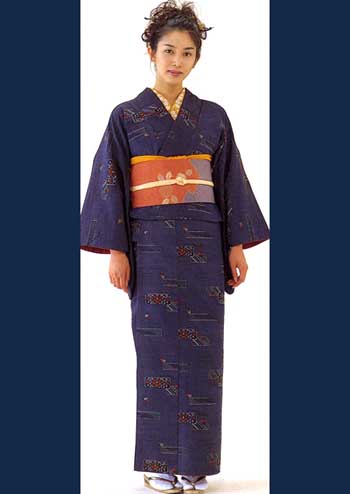By Christopher Schwebius


Japanese history includes alternating periods of isolation and revolutionary influences from the rest of the world. As early as the Jomon period from about 14000BC to 300 BC, Japan had a hunter-gatherer lifestyle; wooden stilt houses, pit dwelling, and agriculture. Weaving was still unknown and the ancient Japanese clothing consisted of fur. However, some of the world's oldest pottery is found in Japan, along with daggers, jade, combs made form shell and clay figures.
The period thereafter to 250 BC saw the influx of new practices like weaving, rice sowing, iron and bronze making influenced by china and Korea. Chinese travelers describe the men 'with braided hair, tattooing and women with large, single-piece clothing.' Initially ancient Japanese clothing consisted of single piece clothing. The ancient and classical Japan begins from the middle of the 3rd century to 710. An advanced agricultural and militaristic culture defines this period. By 645, Japan rapidly adopted Chinese practices and reorganized its penal code.

The peak period of ancient Japan and its imperial court is from 794 to 1185. Art, poetry, literature and trade expeditions continued with vigor. Warlords and powerful regional families ruled ancient Japan from 1185 to 1333 and the emperor was just a figure head. By the Japanese Middle Ages, Portugal had introduced firearms by a chance landing of their ship at Japanese coast; samurai charging ranks were cut down; trade with Netherlands, England and Spain had opened up new avenues. Several missionaries had entered Japan as well.
Distinct features of the lifestyle, ancient Japanese clothing and women is difficult to decipher for the simple reason that it is super-imposed by the Chinese culture. Ancient Japan readily adopted other cultures and practices and most of its own culture is lost among these adaptations.
Ancient Japanese clothing was mostly unisex, with differences being in colors, length and sleeves. A Kimono tied with an Obi or a sash around the waist was the general clothing and with the advent of western clothing are now mostly worn at home or special occasions. Women's obi in ancient Japanese clothing would mostly be elaborate and decorative. Some would be as long as 4meters and tied as a flower or a butterfly. Though a Yukata means a 'bath clothing', these were often worn in the summers as morning and evening gowns. Ancient Japanese clothing consisted of mena and women wearing Haori or narrow paneled jacket for special occasions such as marriages and feasts. These are worn over a kimono and tied with strings at the breast level.
The most interesting piece of ancient Japanese clothing is the ju-ni-hitoe or the 'twelve layers' adorned by ladies at the imperial court. It is multi-layered and very heavy and worn on a daily basis for centuries! The only change would be the thickness of the fabric and the number of layers depending on the season. Princesses still wear these on weddings.
Since the Japanese people don't wear footwear inside their homes, tabi is still worn. These are split -toe socks woven out of non-stretch materials with thick soles. Clogs have been worn for centuries in ancient Japan and were known as Geta. These were made of wood with two straps and were unisexual. Zori was footwear made of softer materials like straw and fabric with a flat sole.
Ancient Japanese clothes, culture and footwear are slowly regaining their popularity with the western world. There is an honest curiosity in knowing more, wearing kimonos or using silk fabrics with beautiful floral prints from the 'land of the rising sun'.
















No comments:
Post a Comment